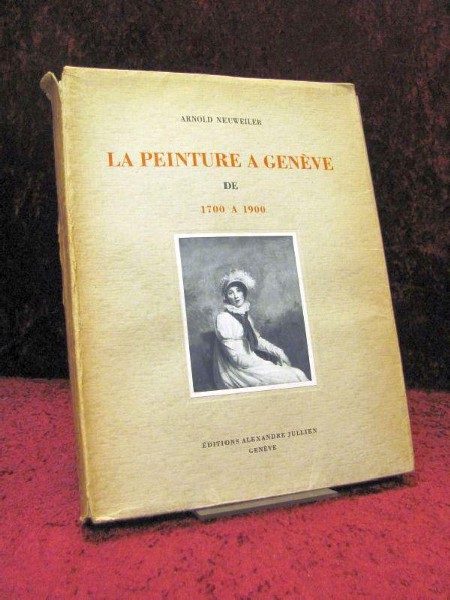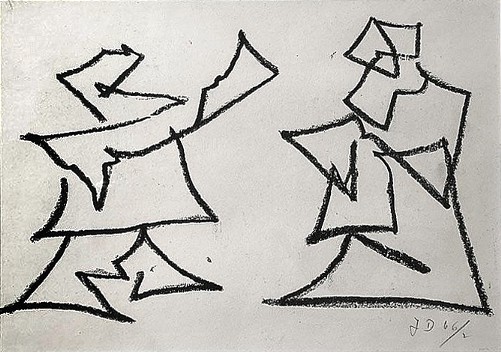Julien Dinou;
Constructing Expressionism
Julien Dinou (Arnold Neuweiler) was born in 1896, Cairo, of Swiss parents. From 1945 onward he started to use the pseudonym Julien Dinou in his work, and partly in his correspondence (among his friends Otto Nebel and Paul Klee).
After he studied chemistry (unfinished) at Bern University (1910–1915), Julien Dinou entered the Max Reinhardt Theatrical school in Berlin. He worked as an actor, stage-manager, and director of plays in the Berlin theater scene. In 1933 Dinou returned to Switzerland to take over his father’s enterprise, which he expanded into a renown company in the field of European railway construction.

To balance his technical and commercial activity, Dinou became increasingly interested in painting, a territory which was not entirely new ground for him. During years of historical and personal artistic research he wrote the book “La Peinture à Genève de 1700 à 1900” (Painting in Geneva from 1700 to 1900), published in 1945. At the same time, he already created paintings with a very personal character. From 1951 onward his paintings were exhibited regularly, without him giving up his engineering job.
Julien Dinou took a very active role in life, in many ways, excelling in each field. He was an extremely sensitive man, totally independent, a person who never hesitated to follow his vibrant impulses.

Taken in consideration the natural evolution of his character during his lifetime, and the influence of environmental factors, certain tendencies appear; hidden or obvious, entwining his work.

Although it is difficult to rely on definitions, we can say that Dinou must be considered an {abstract} expressionist, with a totally distinctive oeuvre. His expressionism has roots in his personal psychological structure and is hardly influenced by main artistic trends. Focusing on the progress in his career we discover {in chronological order}, the birth of genre, recurring motifs and his metamorphosis.
Intermission

What we can discover in Dinou’s work is an “idea” of the mechanics of memory. We find elements of abstraction, but it doesn’t seem systematic, it rather displays a spontaneous outburst, directed through emotion. The figurative and the abstract run criss-cross through each other. Dinou started out with two directions of paintings: (1) the natural & (2) the figurative (1944–1955).

In the work: Jean parle dans les Désert (1951) he paints a disturbing portrait with double vision{Diplopia}. A surprised “primal” expression, bursting through the canvas, reminding us of Munch’s Scream . A green face with four eyes, two noses and a neck as thick as a tree trunk.
Here we can discover the first signs of dualism~non-dualism; a theme running through all his oeuvre. A bizarre portrait representing the dilemma of dualism~non-dualism between nature and being {man}.

In 1951 he painted “Les Adieux, 1955” {symbolic cognition}, a key work in the understanding of his artistic development. A man with a high hat, privately smiling towards the viewer, parted with a crying, yellowish, sick looking woman. In the background we see the sea, sun {or moon}.
The woman and the sea are painted in the same color palette, the wavy hairs merge into the water. On the right a glimpse of a curtain.
That’s all. The show is over.

Reverse engineering of Impressionism
During his time in Paris, when Dinou decided to completely focus on painting, his work developed into a vivid, joyful, and colorful abstract language. His city- & landscape paintings recall French impressionists {École de Paris, which he encountered during his time in Paris}, but in a simplified iconographic fashion, and with a very personal {inward looking} optic.
As a true {Al}chemist, he turned what he discovered in the impressionist method, around. Instead of analysing the {general} space out there, he analysed his {personal} memory of space within, using an impressionist toolset.


Compositions which were carefully constructed while going through a system of Time~Memory. Titles of paintings were given according to the places he visited in the years. We can find curvatures {landscapes} with musical origins (Andante). Feelings of a rendezvous with flowers, with nature; appearing as sighs {unidentified signifiers} in a streaming melody.


Resolving Cubism
Other works of Dinou remind us of the endeavors of the analytical Cubists, but again with a very personal optic.

“Les Deux Villages” (1976) at first sight recalls the optics of a cubist still life. But when we look longer we can discover two similar looking blobs with a multitude of colored planes {hyperdimensional-objects} [as fishes with scales] twisting around one point.
The background consists of absolute blackness {emptiness} and an hourglass figure in earthly brown. What seems to be a butterfly and other, more unrecognizable signifiers, flying in opposite directions. The object in the down-right corner recalls an image of broken glass, but also a sharp point stuck into the middle of a surface[plane]. The cubist broke reality in a multi-view perspective and assembled their subjects into hyper-dimensional objects.*
Dinou took two hyper-dimensional objects {scaled blobs} and twists them {torsion} around one unifying point; creating a Time~Machine compressed in one unique image.

A play with the similar theme of conflict between dualism~non-dualism can be found in a painting of two abstract figures arguing (1956/1957). {The composition of two figures is a recurring element in his paintings}. There is an expressionist outburst of great intensity.

Both figures are composed of rags, juxtaposed on a blue plane, which lies on top of a “light” background. The figure on the left with a closed sphere as head, the figure on the right with a broken sphere, shattering into particles.
Arena
The relationship between time and memory returns in a small pastel drawing called “Arena” (meaning Sand {Egypt} in Spanish, but also a synonym for theater). A priest running hastily clockwise. on a track marked out of colored rags[planes], outlining the eye.
Later again in an untitled work consisting of only a background animated by a thousand specks giving a lively effect. The eye (elliptical movement) is once again present, formed by the specks, a constructed impression. The beholder(man) and the perceived(nature) arrive at the same moment in time, a non-dualistic principle.

Sacred Geometric
During his lifetime, his way of painting developed in a more concentrated and articulated manner: schematizing landscapes, towns, architectural forms and even characters, finally arriving at pure abstract geometric compositions.

The technical perspective
If we stand in front of a hundred and fifty or so of Dinou’s paintings taken at regular intervals, three phenomena may be observed.
1. True consistency of hues. It is quite remarkable to see the same blue or orange, for over a period of 27 years.


Dinou either uses oils or pastels: pastel drawing, a technique he used in his later life, brought a certain satisfaction, both in quick-brilliancy and softness. These pastel paintings are usually dated by year and month, the change of season directly affects emotion; made visible in colour and stroke. Many of his paintings are titled with the names of geographical locations, which he visited through memory.
2. In 1955 [Les Adieux, 1955] a metamorphosis is visible in the work of Dinou. The switch between a dark, figurative approach to a clear, abstract, constructed way of defining art.

3. The third phenomenon was around 1960, showing a sudden rise in the intensity of tones, an exaltation of light in the background, which helped to bring out motifs.

Julien Dinou, undated (1961, June), Swiss private collection
Julien Dinou was an artist with a wide range of possibilities, who, gifted with a strong personality, establishes himself as a centre of exceptional experimental density. He knew how to give free play to essential plasticity, creating vivid images with a childlike, poetic touch. He recognized formal and spiritual connections between very different subjects and places. This is the true soul of creative intuition.
Julien Dinou; Constructing Expressionism. All notes are linked {integrated}. Information and excerpts from the monograph Julien Dinou with texts by Robert Vrinat is used in this essay. [Educational Purpose Only] Triple-A Society, M. Production© 11.2019